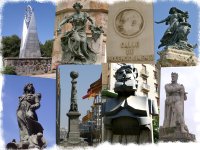Conclusion

We have only talked about the city center, but, if we consider a largest area, we should mention other interesting examples that witness the historical period when they were planned. In little more than a hundred years, the city has experienced a deep change, both from an urban point of view as from making reference to commemorative sculptures that have been built. Remembering certain celebrities and relevant events in the local or national history as a way of collective reaffirmation, the defence of certain values and the expression of rejection or support for certain causes, has been constant along this time. Several present-day works show that evolution has been slow. From big works to humble tombstones, ornamental value is added to history; the history of the event we commemorate, and the way the idea came up and was planned, sometimes thanks to the effort of citizens through popular subscriptions.
As we have seen, building monuments to remember great historical figures was typical of the 19th century, but also of the next century, with all kind of initiatives to pay homage to characters from the past, such as Alfonso the Battler and the Argensola Brothers, both monuments made by the local sculptor José Bueno; or in the 60s the Monument to Ferdinand the Catholic, by Juan de Ávalos. Even more recently, projects such as the Hommage to Al Mutamán, by Sergio Ibraín. A special case was the monuments to the heroes of the Sieges. We have commented on some of them placed at the city centre to commemorate the 100 years of the event, but we must also make reference to the Monument to Agustina de Aragón and the Heroines of the Sieges, planned by Mariano Benlliure and placed at the Portillo Square. Later on, other important figures of Zaragoza Sieges -that had not received the recognition they deserved- have been paid homage. For that reason and despite the time passed, these figures were recovered and immortalized in monuments such as those devoted to the Tío Jorge, or General Palafox on horse. More humble tributes to recent contemporary figures have also taken place, such as busts, relieves and plaques placed in different areas of the city, representing many different figures of the local and regional history considered important by citizens and institutions. As an example, the monuments devoted to Pardo Sastrón, Miguel Allué Salvador, Ricardo Magdalena, Rodríguez Ayuso, Galán Bergua, Isabel Zapata, Miguel Asín, Ángel Sanz Briz, Antonio Beltrán, or Mauricio Aznar.
On the other hand, there are other commemorative monuments in other city districts made as tribute, not to people but to abstract ideas. Some of them are very famous, such as the Monument to the Homeland Altar, originally named Monument to the Heroes and Martyrs of our Glorious Crusade, a huge but unfinished work, since the groups of sculptures closing the Pilar Square between the Basilica and San Juan de los Panetes were not built. After being moved, it can be seen today, with certain changes, at the entry of Torrero Cemetery, highlighting its funerary characteristics. Among the least known monuments, we can mention the monument To whom Died for Freedom and Democracy 1936-1938 and the Post-war, composed of a simple silhouette placed in the cemetery; and the National Monument to Dead Legionaries, placed at Venecia Pine Forest, opposite the funfair. This monument has had a life full of incidents, such as vandalistic attacks, a reprehensible behaviour that has affected also to other monuments of Zaragoza during the past century. Nevertheless, the problem of neglect, graffiti drawing, and damages -in the majority of cases without any ideological base- affects to a large percentage of local public sculptures. These attacks alter original works, which are defenceless against the ignorance of a society that destroys the heritage that they decided to create in the past. Having a walk by our parks and squares, and looking at some of our commemorative sculptures, we are aware that education is essential for preserving those works of art.